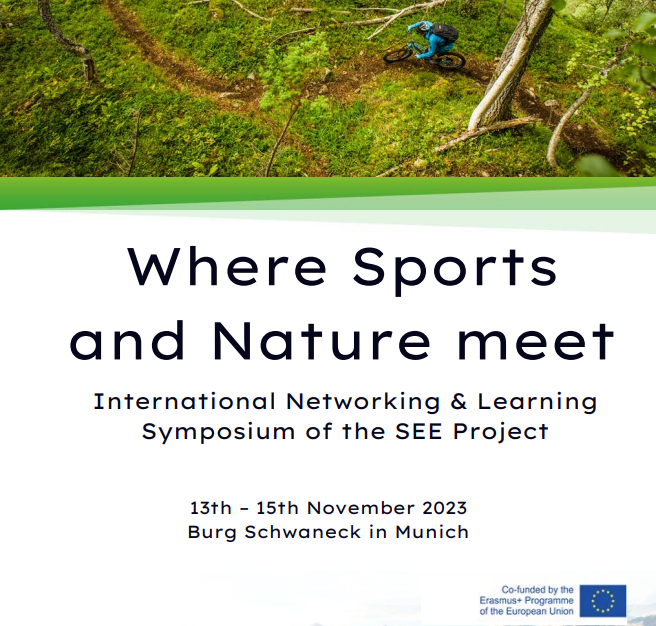Mitigation and management across wind energy and other sectors – Sustainable development in protected areas
Caitlin Cunningham At the PWN purification area at the North Holland Dune Reserve.
Every year, the Alfred Toepfer Natural Heritage Scholarship supports the work of young conservationists in Protected Areas across Europe. Caitlin Cunningham is one of the three Alfred Toepfer Scholarship winners of 2022. In this article, she details the findings of her study visits, where she looked at mitigation and management across wind energy and other sectors.
Article written by Caitlin Cunningham, she works across marine renewable energy at NatureScot – the lead public body responsible for advising Scottish Ministers on all matters relating to the natural heritage.
Mitigation and management across wind energy and other sectors
Sustainable development in protected areas
We are currently in a twin climate and biodiversity crises. Marine renewable energy provides an opportunity to benefit climate change production, whilst simultaneously protecting and minimising impacts to biodiversity.
Across the North Sea, offshore wind is a rapidly expanding industry. Both Scotland and the Netherlands have high ambitions for the expansion of offshore wind energy. Over 45 GW of offshore wind is potentially already in the pipeline in Scottish waters, when including sites that are at the pre-application (prior to consent) stage. Meanwhile, the Netherlands have set an ambitious target of 70 GW of offshore wind by 2050. Dutch offshore wind farms are also at the forefront of biodiversity benefits, with commitments to nature-inclusive design and the development of innovative mitigation measures to protect and enhance biodiversity.
With the support of the Alfred Toepfer Natural Heritage Scholarship, I visited the Netherlands to better understand these novel mitigation techniques, potential compensation measures and examples of nature-inclusive design. I visited three nearshore wind farms – Eemshaven wind farm, Fryslân wind farm and Maasvlakte II wind farm – all located within or nearby protected areas.
Check out the video she created during her visits!
Eemshaven wind farm is adjacent to the Wadden Sea Natura 2000 site. This is a particularly important site for birds, given it is located on a major migration route. Thus, a pilot project is being trialled at Eemshaven wind farm, which involves painting one of the blades of a wind turbine black to assess the effectiveness in reducing the number of collision victims among birds. This follows on from a similar study conducted in Norway, which found a reduction of 70% in the annual collision rate, with the biggest benefits for raptor species. Monitoring is ongoing and the first year of results will be reported later in 2023, with the full project running until September 2024.
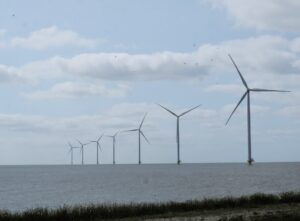
Birds flying through the Fryslân wind farm – Caitlin Cunningham
Fryslân wind farm is located within the IJsselmeer Natura 2000 site, adjacent to the Wadden Sea Natura 2000 area and is therefore an important area for many breeding and non-breeding birds, especially waterfowl. Radar is being used at this location, along with regular visual observations by ornithologists, to monitor and validate collision estimates and modelling parameters at the EIA stage. Currently, the radar is not able to identify birds to a species level. In the future, it is hoped that the radar can be trained using the visual observation data to potentially identify more distinctive species. Furthermore, an artificial island was built as a nature reserve, to further benefit biodiversity and help Fryslân wind farm be nature-positive, with the aim to leave lake IJssel in a better condition.
Maasvlakte II wind farm is a coastal development, located adjacent to the Voordelta Natura 2000 site, which is an important area for migratory birds. Nearby, a gull colony in the urbanised Port of Rotterdam area (Europoort to Maasvlakte) is home to approximately 20,000 breeding pairs of lesser black-backed gulls, with a smaller population of herring gulls. To mitigate this collision risk, a radar is being used to continuously track bird movements, with this data then used to automatically shut down turbines as needed.
Additionally, I learnt more about how these approaches are applied at offshore wind farms in the Dutch North Sea, drawing comparisons to offshore wind energy in Scotland. To achieve this, I visited two specialist locations – University of Amsterdam and the Offshore Expertise Centrum (OEC). During my study visit in May 2023, turbines at two Dutch offshore wind farms, Borssele and Egmond aan Zee, were temporarily shut down to help migrating birds pass safely. This is an international first and a positive measure for birds, especially given the global importance of the East-Atlantic flyway for migration, which crosses the North Sea.
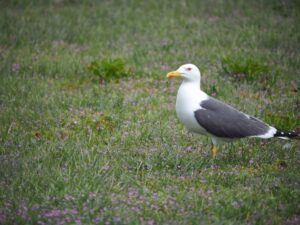
Lesser black-backed gull at Maasvlakte – Caitlin Cunningham
I was also interested in lessons learnt from other industries. I visited the Voordelta Natura 2000 site and learnt about the formal fisheries-based compensation associated with the expansion of the Port of Rotterdam in this protected area. The European Commission gave permission for the expansion on the condition that the habitat loss be compensated. However, it has come to light that the compensation has not been effective and other measures must quickly be secured.
To better understand how other industries implement sustainable development in protected areas, I visited a water treatment plant and the North Holland Dune Reserve managed by the water company, Puur Water & Natuur (PWN). As part of the water purification process, water is transported to the dunes on the coast to naturally filter the water. To improve the condition of the reserve, infiltration ponds and dune slacks have been redesigned, to help promote the young successional stages of wet dune slacks. As sea level rise increases, this poses a risk to the drinking water supply through saltwater intrusion. Thus, the drinking water companies have a vested interest to conserve and enhance the dune systems to improve resilience to future threats and preserve the ecosystem services the dunes provide.
The associated report presents the findings of my visit, including recommendations for the offshore wind sector, with a particular focus on relevance to Scotland.
Where Sports and Nature meet | International Networking & Learning Symposium of the SEE Project
The partners of the Sustainability and Environmental Education in Outdoor Sports project (SEE) invite you to attend the final Project Learning Symposium in Munich from the 13th – to the 15th of November 2023. The main program is scheduled for the 14th of November.
The SEE Project aims to enhance the protection of natural landscapes through education in and through sport with special focus on responsible outdoor behaviour and skills development for outdoor sports leaders, trainers, guides, or instructors.
During the SEE Learning Symposium, hosted at the beautiful Burg Schwaneck just outside of Munich, attendees will learn about current challenges and opportunities of outdoor sports practiced in (Protected) Natural Areas and how to address these through newly developed training methodologies in Outdoor Sports education.
The programme
The symposium is an opportunity to bring together an international audience from both the outdoor sports sector and the environmental protection sector to share ideas, transfer knowledge and work on future collaborations. The program will include ample opportunities to learn and network from one another through various facilitated networking sessions with project partners and experts, interactive activities, and demonstrations of the SEE Educational Toolkit.
The learning symposium will be a full-day programme (Tuesday) which includes practical workshop sessions where partner organisations of the project will demonstrate several toolkit activities. In addition to the toolkit demonstration, the program will include inspirational speeches from leaders in environmental activism, networking activities, dinner, and social program in the evening.
Extend your stay and join the SEE project partners for an early bird outdoor activity on Wednesday morning followed by a workshop session and a deep dive networking session which will focus on specific topics related to different environments and sport types.
Download the Programme now!Is this event for me?
If you are working in the outdoor sports sector as trainer, tutor, or any other educational role (eg. at a Sports University, sports federation, outdoor training centre, VET provider in the field of OS), or in the outdoor sports / adventure travel tourism sector, then this Learning symposium is the best opportunity to gain new insights in the latest developments of sustainability and environmental education in outdoor sports.
Are you working for a National Park or Protected Area (e.g. member of the EUROPARC Federation) or working with guiding companies, travel agencies in your capacity as land manager, outdoor recreation manager, forestry manager etc.? Then this learning symposium will have valuable insights for you as well and provide great opportunities to have a dialogue to strengthen the relationship between nature and the outdoor sport sector.
Ticket fee
Registration for the event includes lunch, coffee breaks and dinner on Tuesday (other meals /drinks are at own expense). The ticket fee of €20,- will be used to offset the total carbon footprint of the event (e.g. international travelling and overnight stays of the attendees). Of course, participants are encouraged to make use of public transportation as much as possible.
Register here!Call for contributions
The closing date for the submission is 30th September 2023
I want to contribute!If your organisation has been involved in some aspect of innovative sustainable or environmental education practices, then we would love to hear about it and share your ideas with others.
End of an era – in memoriam Prof. Dr. Hans Köpp
It is with great sadness, that EUROPARC learned about the passing of Prof. Dr. Hans Köpp on 23rd of June 2023 at age 85.
With the passing of a generation, we should pause and reflect on their vision and contribution in our lives and society. It is therefore with sadness that EUROPARC reports the recent passing of Herr Köpp. He was one of the founding fathers of EUROPARC and the last to be directly connected to the very beginning of the Federation, working in close collaboration with Dr Alfred Toepfer. Working as a forest scientist, Prof. Dr Hans Köpp was, for a time, executive director of the Federation. However, his main functioning was editor of EUROPARC bulletin from 1973-1985.
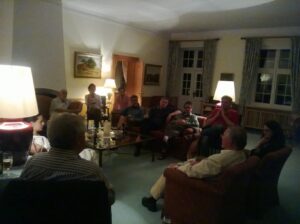
EUROPARC share an evening with Prof. Dr. Hans Kopp, in Gut Siggen, regaling stories of the early days of EUROPARC.
As such, he was at the centre of news, information, ideas and connections across the European park’s community and was especially a bridge between East and West Europe. Herr Köpp, shared his inspirational story of how the first Protected Areas in Europe came together, despite the political turmoil and life behind the iron curtain for many early EUROPARC members.
Prof Dr Köpp was also very connected with the Alfred Toepfer Academy for Nature Conservation in Lower Saxony. He began cooperation with strategic partners at home and abroad at an early stage, much of which continues to this day, including EUROPARC’s close and ongoing partnership.
Some EUROPARC members had the privilege to share an evening, with Herr Köpp sharing his fascinating experiences about how the Federation was born and grew, in our 40th anniversary in 2013. It was a privilege to enjoy his witty and engaging stories. EUROPARC captured Herr Köpp’s reflections further, in this lovely film published in celebration of our 50th anniversary.
Herr Köpp was a charming gentleman, full of joy, with twinkling eyes that retained their excitement for the future of EUROPARC. We are lucky to have captured the quiet wisdom of his experience. It is both the end of an era but, too, the relentless forward march of time for the Federation. We look back to his generation with gratitude.
Our deepest condolence goes to the Köpp family.
EUROPARC participates in the World Protected Areas Leaders Forum
On 26-30 June, the World Protected Areas Leaders Forum (WPALF), initiated by IUCN, took place in the Krkonoše National Park and the Jizera Mountains Protected Landscape Area. EUROPARC Federation was represented by its President Michael Hošek.
About the Forum
Around 20 Protected Area leaders and specialists came together in the Krkonoše National Park and the Jizera Mountains Protected Landscape Area. The purpose of the meeting is not only to enable leaders in Protected Areas management to discuss and share experiences, but above all to identify the problems and challenges Protected Area managers are facing, or are likely to face. Furthermore, it offers a chance to prepare our community to respond appropriately to them.
Our protected spaces are important drivers of sustainable development
It’s time to champion our Protected Areas
Protected Areas are one of the most successful conservation tools, and their benefits can be identified on many levels. This is exactly EUROPARC’s role: to identify and promote Protected Areas as a tool that, far from just serving nature conservation, is already serving sustainable use in general.
Protected Areas support greater involvement of local communities and local governments, also in partnership with the private sector. However, to make the most of our Protected Areas, continuous investment is needed. The wealth of knowledge the global Protected Area community holds is immense. Adapting current policies to make use of this wealth is pertinent if we want the Global Biodiversity Framework, adopted in December 2022, to be a success.
As a result of the meeting, Protected Area managers signed a declaration underlining this sentiment. You can read it here:
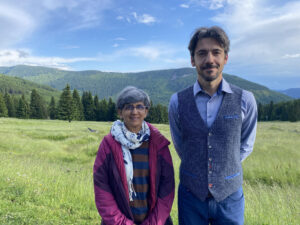
Michael Hošek and Madhu Rao at the World Protected Areas Leaders Forum 2023.
WPALF Krkonoše – Jizera Declaration
Furthermore, EUROPARC president Michael Hošek attended a separate meeting with Dr. Madhu Rao, the Global Chair of the IUCN World Commission on Protected Areas (WCPA). They discussed further close cooperation between EUROPARC and the IUCN WCPA.
